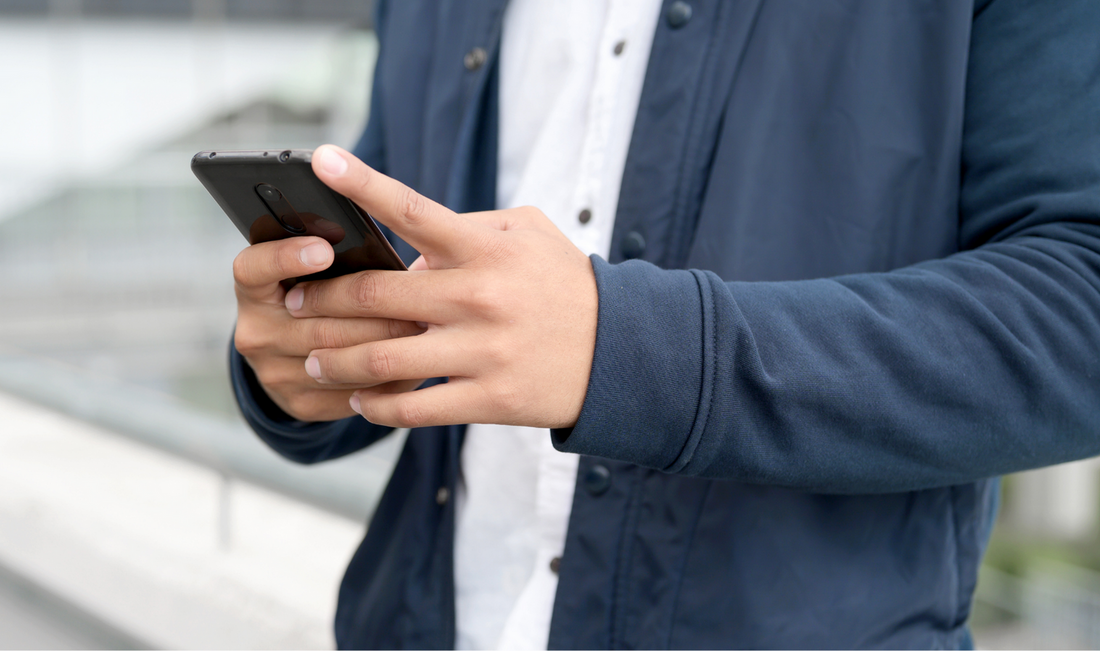What's the first thing you do when you wake up? If you're like 89% of Americans, the answer involves reaching for your smartphone and diving headfirst into the digital world. You check your emails, scroll through your social media feeds, and catch up on the latest news—all before your feet even touch the floor.
In today's digital age, most of us are constantly attached to our cell phones, and this endless connection can profoundly affect our well-being. But fear not—you don't have to be addicted to your device if you don't want to be. In this guide, we share how to limit screen time and regain control over your digital life.
Defining Cell Phone Addiction
Cell phone addiction is characterized by excessive and compulsive use of cell phones to the detriment of your daily life and well-being. Surprisingly, it can often fly under the radar, with individuals not fully aware of how frequently they reach for their phones or the subtle ways it's influencing their lives.
This addiction often manifests through behaviors such as:
- Constantly checking for notifications
- Compulsive social media scrolling
- Reaching for your phone whenever you have a moment of downtime
- The inability to disconnect even during important or inappropriate moments
- Feeling anxious if you can't find your phone or are separated from your phone
If this sounds familiar, you're certainly not alone. In a survey by Reviews.org, nearly 57% of Americans said they're addicted to their cell phone.
Doomscrolling: A Cycle of Never-ending Negative News
There's one particularly concerning behavior that has become increasingly prevalent in recent years—doomscrolling. Doomscrolling is a subset of cell phone addiction characterized by obsessively scrolling through news articles and social media feeds, often focusing on negative or distressing content.
This behavior is typically driven by a desire to stay informed about current events, which is undeniably important. It can empower us to make informed decisions and engage in meaningful conversations.
But it's equally crucial to strike a balance. Constant exposure to distressing news can lead to heightened stress levels, anxiety, and feelings of hopelessness.
Why Are Cell Phones So Addictive?
A big part of the allure of your smartphone lies in your brain's reward system. When you encounter new information, especially if it's emotionally charged, your brain releases dopamine, the "feel-good" neurotransmitter. The same thing happens when you receive a notification that you have a new text, email, or comment on Instagram.
This dopamine rush can create a cycle of seeking out more and more information, even if it's causing stress or anxiety. You become addicted to scrolling and checking, always chasing that next dopamine hit.
On top of that, many apps are intentionally designed to be addictive. This design serves the interests of app developers, as user engagement directly correlates with their revenue. One example of this addictive design is the inclusion of infinite scrolling features, which entice users to continuously consume content without a discernible endpoint.
Chances are, we've all fallen victim to this phenomenon—a seemingly innocent intention to check "just one thing real quick" spirals into a deep rabbit hole, and before you realize it, half an hour has vanished into the digital abyss.
The Pros and Cons of Staying Connected
It's important to acknowledge that smartphones offer numerous benefits, so you shouldn't write them off entirely. However, with access to these benefits comes the potential for recreational overuse. Over time, spending too much time glued to your cell phone screen can result in several adverse effects, including:
- Sleep Disturbances: Excessive screen time, especially before bedtime, can disrupt sleep patterns. The blue light emitted from screens suppresses melatonin production, a hormone that makes you sleepy.
- Eye Strain: Too much screen time can lead to digital eye strain, causing symptoms like dry eyes, blurred vision, and headaches.
- Mental Health Issues: Constant connectivity to news and social media use can contribute to heightened anxiety, depression, and stress levels.
- Decreased Productivity: Excessive cell phone use at work or during study sessions can lead to reduced productivity and a lack of focus.
- Reduced Real-Life Interaction: As cell phone addiction grows, face-to-face interactions can suffer. You may find you're more engrossed in your screen than in real-life conversations, leading to feelings of isolation and loneliness.
Digital Detox: Tips for Reducing Your Cell Phone Screen Time
Now that we've peeled back the digital curtain and uncovered the not-so-glamorous side of excessive cell phone use and its sneaky impact on your well-being, it's high time we staged an intervention.
Here are some practical tips and strategies to help you spend less time on your smartphone:
#1: The Phone Foyer Method
This ingenious idea, courtesy of author Cal Newport, is as simple as it is effective. Designate a location in your home—a "phone foyer"—where your cell phone spends its downtime.
When you return home, put your phone in its foyer and leave it until the next time you leave the house.
If you need to look something up or use your phone, go to your phone foyer and use your phone there.
- What if you're sending text messages back and forth with someone? Stand next to the foyer while you do it.
- What if you feel the urge to check your Instagram? You go to the foyer and check it.
- What if you're expecting a phone call? Turn the ringer up as loud as it will go so you can hear it from across the house.
This method encourages you to consciously contemplate the use of your phone instead of reflexively reaching for it simply because it's right next to you.
#2: Change Your Phone Screen to Black and White
Colors and shapes are typically the first things that grab your attention when you look at your phone. The solution? Make your phone boring by changing your screen to grayscale.
To do this on an iPhone:
- Open the Settings app.
- Tap on "Accessibility."
- Tap on "Display & Text Size."
- Tap on "Color Filters."
- Toggle the switch to turn "Color Filters" on.
- "Grayscale" will be on because it is the first one selected.
For Android directions, click here.
Go ahead, try it. POOF! Did you feel the allure vanish? Open your favorite apps, and you'll wonder why on earth you spend so much time on them.
#3: Set Notifications to Silent
The relentless ding, ping, and buzz of notifications can be incredibly distracting, drawing you into your phone's digital vortex every time several times a day. Take control by turning off all notifications (except maybe phone calls).
Instead of letting notifications dictate your day, schedule specific times to check your messages, emails, and social media. By doing this, you regain control over when you engage with your phone, reducing the constant pull of alerts.
#4: Try Screen Time Apps
There's an app for everything, including curbing your screen time. Explore screen time management apps that allow you to set limits for your time on specific apps. Some options include StayFocused, Jomo, ScreenZen, and Freedom.
#5: Work on Underlying Motivations
Sometimes, excessive cell phone use is a symptom of underlying emotions or unmet needs. Take some time to reflect on why you reach for your phone so often. Are you seeking distraction from stress, anxiety, loneliness, or boredom? Identifying the root causes can help you address them more effectively.
Once you've pinpointed your motivations, explore healthier alternatives for addressing those feelings when they arise:
- When you feel stressed or anxious, do a 5-minute meditation, deep breathing exercise, or physical activity.
- When you feel lonely, chat with friends, plan a social activity, or try spending time with your pet.
- When bored, pick up a new hobby or learn something new.
Addressing the underlying issues can reduce the urge to use your phone as a coping mechanism.
#6: Have Screen-Free Meal Times
Make mealtime a sacred screen-free zone. Put away your phone and focus on your food's flavors, textures, and aromas. If you're dining with others, engage in conversation with family members or friends.
This mindful approach improves your digital well-being, enhances your dining experience, and fosters meaningful connections with those around you.


The Good Stuff - Focus
-
Stimulates cognitive function and mental clarity.
-
Slow-release energy and mood enhancer.
-
Delicious mocha flavor you have to try to believe.
-
Unique formula, only available at For Wellness.
#7: Incorporate The Good Stuff™ Focus
Consider incorporating The Good Stuff™ Focus into your routine. While this performance coffee supplement won't act as a magical barrier against your phone, it may help enhance your ability to maintain focus on your current task. This benefit is thanks to the inclusion of theobromine—a cacao extract and the ultimate focus supplement.
This delicious, mocha-flavored powder—which is perfect for adding to coffee, tea, or smoothies—also includes L-theanine, collagen, organic cinnamon, and MCT, which collectively support cognitive function, mental clarity, energy, and mood. These benefits can contribute to fostering a more balanced relationship with your smartphone.
And for a focus-promoting snack, grab our Superfood Focus Bites. Made with Lion's Mane mushroom and guarana seed, these chewy brownie bites trigger the production of neurotransmitters in the brain that encourage calmness and concentration. They help our co-founder and golf legend Phil Mickelson stay focused on the golf course! 💡Find more tips for increasing your focus here.
A Final Word on Screen Detoxing
While smartphones have become indispensable tools, finding that balance between staying connected and preserving your well-being is essential.
To recap, here are some tips to kickstart your screen detox:
- Leave your phone in its "phone foyer" when you're home.
- Change your screen to grayscale.
- Turn off unnecessary notifications.
- Try screen-limit apps.
- Work on resolving underlying emotions or states of being, such as boredom or anxiety that trigger excessive phone use.
- Incorporate The Good Stuff™ Focus and Superfood Focus Bites into your routine.
And hey, if all else fails, you could always consider a radical move and switch back to an old-school non-smartphone. Just kidding—if you take these tips seriously, rockin' a "dumbphone" shouldn't be necessary. We believe in your ability to conquer digital temptation and find that perfect balance!
We take the cutting-edge functional foods fueling elite athletes and create delicious products that seamlessly integrate into your daily routine because everyone deserves a chance to optimize their daily performance.
Written by Katie Koschalk, a health and wellness writer, certified holistic nutritionist, and certified personal trainer based in California.















